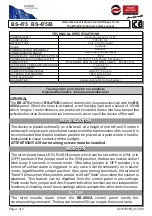
Page 2 of 4
RANGE
TEST
RANGE TEST
SETUP
SETUP
Installation should only be carried out by
quilified
technicians.
To install, follow the procedure below:
1.
Remove
the retaining
screws
from
the
front cover
of the device (Photo 1).
2.
Remove
the retaining
screws
from
the
inner cover of the device
(Photo 2).
3.
Drill with a 6mm diameter drill bit on the wall and place the
mounting
materials at
the
4
indicating
points
(Photo 3)
so as to
fasten
the device.
4.
Connect the battery
(
ATTENTION
!!!
The red wire to the positive
pole
(+))
, r
e
-install
the
in
ner protective cover
and fasten it with the retaining
screws
that you removed in
step 2.
5.
Re
-install
the
front cover
and fasten it with the retaining
screws
that you removed
in
step 1.
6.
The device is ready to operate.
ATTENTION!!
When the BS-468/A panel is in wireless installation mode and we want to insert the
BS-475 or BS-475/B siren into the network, one of the 2
photovoltaic
panel's cables in the KL1 terminal
must be removed before we install the device in the network. When the device enters the network, the
cable must be re-installed to the KL1 terminal.
ALARM DURATION
ALARM DURATION
The siren is in alarm mode as long as there is an alarm signal. At the
BS-468/A
there is a user's
setting
,
to select 1 or 2 minutes.
There is an absolute security limit of
5
minutes, above which it stops sounding
irrespective of the command it is selected from the control
panel.
Also, if the battery voltage
is
low (lower
than 5.5V), the siren will not sound irrespective of the command it takes from the
control
panel
.
Once the device is connected to the panel's network, remove the battery and wait for 10 seconds.
Then press the
tamper
and re
install
the battery. Wait until the beacon lights up. Once you release the
t
amper, the beacon will go out. In this case, the range TEST will start.
During
range test
beacon
blink
s every second. The duration of
range test
is 60-95 seconds. When it is finished the
beacon
goes off
and after 2 seconds the
test
result
is displayed
as follows:
Single
blink
:
Strong signal.
The device can be
safely installed
at this point.
Two
blink
s:
Normal signal.
The device can be safely
installed
at this point.
Three
blink
s:
W
eak signal.
It is
recommended
not to
install
the device
at this point.
T
he
re will be communication bettween the device and
the control panel
but there will
be communication
packet
s losses
.
Four
blink
s:
Out of range.
The
device
is forbidden to be placed in th
is point
.
Note
: As soon as the
test
procedure is started, it is suggested that the
device
c
over
will
be placed
directly in order to simulate the actual communication conditions. The environment must be also
adapted to the worst possible conditions (e
.
g
.
closed doors).
Finally, in case of
home improvements
or renovation
, it is suggested
to perform a
range test
again
.
9214
75
000_09_0
0
9






















